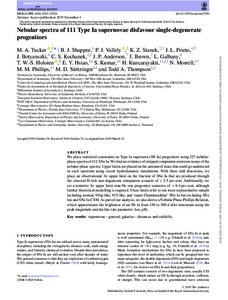Nebular spectra of 111 Type Ia supernovae disfavour single-degenerate progenitors
Tucker MA; Shappee BJ; Vallely PJ; Stanek KZ; Prieto JL; Botyanszki J; Kochanek CS; Anderson JP; Brown J; Galbany L; Holoien TWS; Hsiao EY; Kumar S; Kuncarayakti H; Morrell N; Phillips MM; Stritzinger MD; Thompson TA
Nebular spectra of 111 Type Ia supernovae disfavour single-degenerate progenitors
Tucker MA
Shappee BJ
Vallely PJ
Stanek KZ
Prieto JL
Botyanszki J
Kochanek CS
Anderson JP
Brown J
Galbany L
Holoien TWS
Hsiao EY
Kumar S
Kuncarayakti H
Morrell N
Phillips MM
Stritzinger MD
Thompson TA
OXFORD UNIV PRESS
Julkaisun pysyvä osoite on:
https://urn.fi/URN:NBN:fi-fe2021042823904
https://urn.fi/URN:NBN:fi-fe2021042823904
Tiivistelmä
We place statistical constraints on Type Ia supernova (SN Ia) progenitors using 227 nebular-phase spectra of 111 SNe Ia. We find no evidence of stripped companion emission in any of the nebular-phase spectra. Upper limits are placed on the amount of mass that could go undetected in each spectrum using recent hydrodynamic simulations. With these null detections, we place an observational 3 sigma upper limit on the fraction of SNe Ia that are produced through the classical H-rich non-degenerate companion scenario of < 5.5 per cent. Additionally, we set a tentative 3 sigma upper limit otan He star progenitor scenarios of < 6.4 per cent, although further theoretical modelling is required. These limits refer to our most representative sample including normal, 91bg-like, 91T-like, and 'super-Chandrasekhar' SNe Ia but excluding SNe Iax and SNe Ia-CSM. As part of our analysis, we also derive a Nebular Phase Phillips Relation, which approximates the brightness of an SN Ia from 150 to 500 d after maximum using the peak magnitude and decline rate parameter Delta m(15)(B).
Kokoelmat
- Rinnakkaistallenteet [27094]
